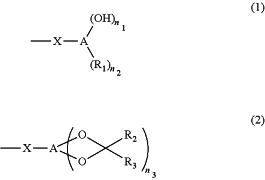| CPC G03F 7/11 (2013.01) [C08G 59/223 (2013.01); C08G 59/26 (2013.01); H01L 21/0274 (2013.01)] | 25 Claims |
|
1. A resist underlayer film-forming composition, comprising an organic solvent and a polymer, wherein one or more terminal ends of the polymer are represented by the following formula (1) or (2):
 wherein, in formula (1) and formula (2),
X represents a divalent organic group;
A represents an aryl group having 6 to 40 carbon atoms;
R1 represents a halogen atom, an alkyl group having 1 to 10 carbon atoms, an alkoxy group having 1 to 10 carbon atoms;
R2 and R3 each independently represent a hydrogen atom, a halogen atom, an alkyl group having 1 to 10 carbon atoms which may be substituted or an aryl group having 6 to 40 carbon atoms which may be substituted;
n1 represents an integer of 2 to 12;
n3 represents an integer of 1 to 12; and
n2 represents an integer of 0 to 11.
|